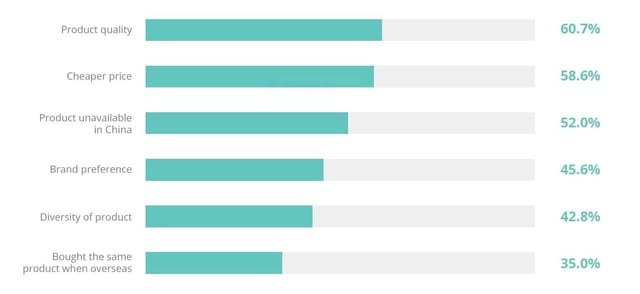China is now the largest online shopping market in the world, reaching USD$683 Bn (RMB 4.7 Tn)1 gross merchandise value (GMV) in 2016, with 467 million digital shoppers and accounting for over 40% of the total global online shopping sales.
This is just the tip of the iceberg. According to Forbes, online sales are expected to grow a further 20%, presenting a tremendous market opportunity to international brands who take the time to fully understand the Chinese eCommerce landscape and adopt a Chinese digital strategy to launch their offering in the Chinese market.
But the question remains, how to sell to China online? Below we have provided some top tips on how you can sell to China online, in order to capture the growing demand for international products.
Understand the key drivers for Chinese consumer demand
This is vital for businesses looking to position their product in the competitive Chinese eCommerce landscape. A burgeoning middle class, as well as increased exposure to international brands, safety concerns with some Chinese goods (particularly certain foods, baby formula and health supplements) amongst others, have given rise to a demand for overseas goods.
According to a study by iResearch2, Chinese consumers are attracted to international products because of:

Leverage your competitive advantage as a foreign brand
What’s more, Chinese consumers are known to closely associate certain values with particular countries or regions. For instance, a study by management consulting firm Bain2 found that Australia is closely linked to notions of health and well-being.
‘When the Chinese think of Australia, it isn’t only kangaroos and koalas that come to mind. They also envision clean air, green grass, pristine beaches, nutritious food and a healthy population. Indeed, Australia is one of the world’s healthiest countries, according to the United Nations, the World Bank and the World Health Organisation3.’
In fact, according to the same research report, Chinese consumers were:
- 1.6 times more likely to associate Australia with health and nutrition than the US, Germany, Japan and South Korea.
- 2.5 times more likely to associate Australia with the word ‘natural’.
This means that businesses that sell Australian products such as food, skincare, supplements, wine or baby formula already have a promising premise just by virtue of being Australian if they play their cards right. However, this factor alone doesn’t guarantee an entry in the Chinese eCommerce hall of fame. Nor does it mean that products in other categories are facing insurmountable disadvantages.
‘When the Chinese think of Australia, it isn’t only kangaroos and koalas that come to mind. They also envision clean air, green grass, pristine beaches, nutritious food and a healthy population. Indeed, Australia is one of the world’s healthiest countries, according to the United Nations, the World Bank and the World Health Organisation4.’
Develop a comprehensive China go-to-market strategy
Sinorbis has seen many successful international brands open up an eCommerce presence in China, only to exit it again shortly thereafter - with nothing to show for but significant financial losses. The mistake that many of these businesses make is that they put action before strategy. They adopt a build-it-and-they-will-come attitude to Chinese eCommerce and wrongly assume that their brand is already well-known in the Chinese market and/or that their existing value proposition will resonate with the local target market. These kinds of assumptions need to be scrutinised and validated before a company even considers opening up an online store in China.
The good news is that the particularities of the market open up a level playing field for businesses hoping to gain traction in China. Any company that is willing to put in the groundwork and research to develop a comprehensive China go-to-market strategy has a chance to set up a successful Chinese eCommerce presence.
1 iResearch. 2016. Annual Data Release Summary Report, 2016. [ONLINE] Available at: http://www.iresearch.com.cn/report/2889.html [Accessed 11 February 2017].]2 iResearch. 2016. China Cross-border Online Shopping User Study Report, 2016. ONLINE] Available at: http://wreport.iresearch.cn/uploadfiles/reports/635941553177667023.pdf [Accessed 11 February 2017].
3,4 Yngve Andresen, Raymond Hass and Jason Ding. 2016. The Hottest Brand in China Is Australia. [ONLINE] Available at: http://www.bain.com/publications/articles/the-hottest-brand-in-china-is-australia.aspx. [Accessed 7 February 2017].











